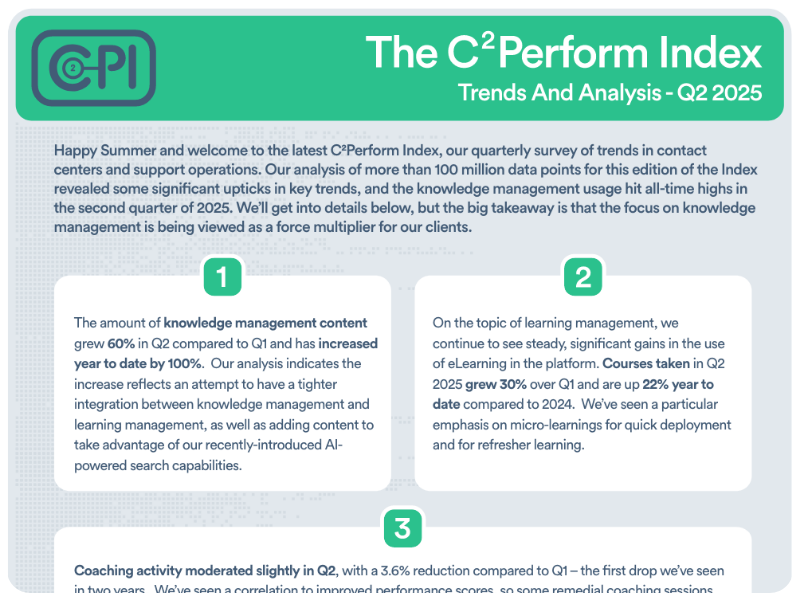Finding ways to maintain or increase employee engagement and motivation is an important part of any leader’s duties. However, it’s often easier said than done. Leaders may find themselves lacking the time and resources they need to drive major employee motivation and engagement initiatives to success.
So, it’s important to find smaller things that you can do to engage and motivate your team. Read on to learn more about some employee engagement techniques that virtually any manager or leader can use!
How Employee Engagement and Motivation Impacts Success
Before we start talking employee motivation techniques, let’s establish why it’s necessary for businesses to motivate and engage their employees as much as possible. Here are a few reasons why it’s important:
- To Improve Employee Retention. Employee turnover can be expensive. In fact, according to Gallup, “a 100-person organization that provides an average salary of $50,000 could have turnover and replacement costs of approximately $660,000 to $2.6 million per year.” Disengaged and unmotivated employees are significantly more likely to quit, so motivating employees can be crucial for reducing voluntary turnover and increasing retention.
- To Increase Employee Productivity. Engaged employees are productive employees. When employees feel engaged and motivated, they’re more likely to put in discretionary effort to produce results and will be more proactive to find solutions to workplace challenges. According to Gallup, the difference in productivity between organizations with top and bottom-quartile engagement rates was 18%.
- To Maximize Profitability. Because engaged employees work harder, avoid absenteeism, and don’t quit as often, organizations can see a 21% increase in profitability (Source: Forbes).
- To Make New Talent Acquisition Easier. Nobody wants to work at a business that’s on a “Worst Places to Work” list. When you drive employee engagement and create a positive work environment, you can encourage employees to rate the business as a great place to work and recommend it to their peers—generating good “word of mouth” advertising for your recruitment efforts. Forbes noted that “89% of workers at companies that support well-being initiatives are more likely to recommend their company as a good place to work.” This helps to make new talent acquisition easier and can help tip the balance for great new talents trying to choose who they want to work for. For example, if you and a competitor are both offering the same pay and benefits, but you have a reputation as being a great place to work and they don’t, you’re more likely to get a high-value talent to sign up to work for your company.
- To Increase Quality and Safety of Work. Gallup noted that workplaces with high engagement saw a 41% improvement in quality (fewer defects in work) and a 64% reduction in safety incidents. This could be attributed to motivated employees more assiduously adhering to company quality assurance and safety guidelines as opposed to looking for shortcuts that save time at the cost of quality and safety.
In short, high employee engagement and motivation help improve work quality, business profitability, reduce safety incidents, minimize voluntary turnover, and can even have an indirect impact on recruitment efforts. So, increasing engagement and motivating employees is a worthwhile effort for any leader.
5 Simple Employee Engagement and Motivation Techniques
How can you increase employee engagement and motivate your team? Driving engagement can be tough—especially when you aren’t getting as much “face to face” time with employees because of remote work or simply being overloaded with your own tasks.
Here are a few simple things that you can do as a leader to drive employee engagement:
1. Giving Out Kudos for Extraordinary Effort and Results
One thing every leader can do that doesn’t take a lot of time is providing some recognition when an employee clearly goes above and beyond the call of duty. When someone achieves drastic results or puts in a ton of extra effort, call them out and thank them!
This can be as simple as stopping by their desk or workstation and congratulating them in person, sending a message complimenting them, or just setting aside some time at the next meeting to say “Thanks to Chuck for absolutely crushing his quarterly sales goals with a month and a half to spare!”
Some leaders prefer a more formal recognition program, however. For example, they use data dashboards to track employee performance and process metrics to positively identify top performers and set up special events to ensure that everyone knows exactly who’s providing the best results. This helps to increase competitiveness amongst team members—motivating them to try to one-up each other to get the best results.
2. Practicing What You Preach
Double standards can be the death of employee motivation and productivity. As noted by the Illinois CPA Society, “if you demand one set of standards of your employees and then work according to an entirely different set of standards you’ll likely be the target of considerable resentment—which breeds disloyalty, lack of motivation and, ultimately, failure.”
In other words, if you want to keep employees motivated, it’s necessary to “practice what you preach.” Setting a good example by following the same standards that you expect of your team can be crucial for maintaining motivation and preventing a disengagement epidemic.
However, it can be hard to show that you’re following the same standards as your team. One way that some leaders do this is by maintaining an “open door” and regularly communicating with employees to show how they’re modeling the behaviors they’re trying to encourage.
3. Make Sure Goals Are Achievable
If employees are struggling to meet productivity goals, is it because they’re underperformers or is it because the goals being set were unrealistic? While setting aggressive goals is a good idea, setting unrealistic goals can be detrimental. When employees continue to miss goals because they aren’t achievable, they may lose all motivation to even try to meet goals.
So, it’s important to periodically review the various goals you set for employees and track how often employees are actually able to meet them. For example, if less than half of all employees in a specific role can consistently meet their goals, there might be a systemic issue keeping them from meeting those goals. Investigating the root cause for the failure could be time-consuming, but well worth it.
Some leaders find that, once they have team members consistently hitting goals after removing an obstacle, they can actually increase the base goal and still have their team consistently meet it.
4. Actively Request Feedback
So, how can you investigate the root cause of low employee engagement? One solution a lot of C2Perform platform users use is actively sending messages to employees asking for feedback about their workplace. In fact, according to the C2Perform Index for Q2 2022, the use of messaging tools had increased fourfold over Q2 2021—demonstrating just how important frequent communication is to effective leadership.
Alternatively, many leaders use an anonymous suggestion box to collect feedback from employees in a way that allows the employees to be open and honest, even blunt, about issues they’re facing in the workplace. Creating a feedback tool that’s risk free can help leaders get information that they would otherwise not be able to learn from just looking at performance dashboards and employee evaluations.
5. Start Linking Employee Activities to a Purpose or Mission
When your employees are completing tasks, what’s the larger mission? Is there a bigger purpose behind the work that helps the employee or someone else? Without a clear link between the work employees perform and a larger goal, motivation can suffer. After all, why would Will from sales care if shareholders will get a 2% larger ROI on investing in the company if it doesn’t help him, his coworkers, his customers, or his community in some way?
So, one way to motivate employees is to create a link between what they do and the direct impacts of those activities on them, their team, their customers, or the community. How can you do this?
Some leaders like to proactively show employees how their work benefits others. For example, a marketing team manager might create a report showing their team how the leads they generated fueled the sales team’s efforts to close more deals. Meanwhile, the sales team leader might show how meeting sales goals helped the rest of the company earn pay increases.
Alternatively, some leaders link specific activities to a larger purpose. For example, a company offering an environmentally-friendly product might have leaders showing how the company’s work is fighting climate change, reducing the amount of waste being sent to landfills, or keeping their local community green. Meanwhile, a healthcare provider might focus on how their services help people lead longer, healthier, and more fulfilling lives.
This helps to add new value to work for employees who are not as motivated by direct monetary rewards as they are by helping others.
Build an Employee Recognition Program Now!
Each of the above employee motivation techniques don’t cost much to use aside from some of your time—especially the recognition program. While setting up a formal system for recognizing employee achievements can be a challenge, there are solutions that can help.
For example, C2Perform has an employee performance data tracking solution and a team communication solution that make it incredibly easy to see when an employee is producing great results and share your congratulations with them. In fact, you can even automate employee recognition with employee engagement tools that automatically acknowledge employees when they hit specific milestones.
Are you ready to transform employee engagement and motivation in your business? Reach out to us today to get started!
 English
English Español
Español









